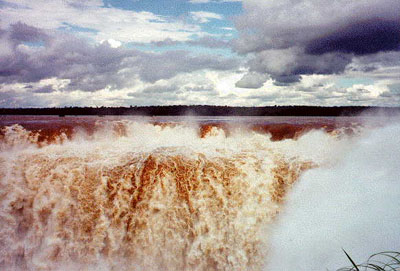

The Iguazu River is a typical watershed for thousands of square miles of rain forest. The river forms a portion of the northern border between Argentina and Brazil (half the river is in each country). There is a point where the plateau upon which the river flows drops about 300 feet, creating the Iguazu Falls, and below it a gorge along which the river continues to flow. So far, simple and clear. So, what's all the fuss?
This is where the words lose out, and the photos, even the video, cannot convey the experience.
The Iguazu Falls consists of 275 to 350 separate falls (depending
upon whether it is the wet or dry season) spread across a 1.5 mile
wide ridge. The falls are like a living dynamic work of art, of
tumbling water, some falling with an even flow like a curtain,
some cascading over rocks in a burst of energy. The river runs red
with soil, so from some views the falls look angry with torrents
of red water gushing down and crashing on the rocks below. But
from some views the falls glisten white as the water makes it leap
over the chasm. Mist and foam are everywhere. Even from the
airport, 10 miles away, we could see the cloud of mist from the
falls.
 |
 |
| Earth being carried over falls | View from Argentina side; note boat in middle of picture entering falls |
We experienced the falls by spending hours on a series of
walkways on either side of the river. The walkways are a series of
bridges and stair cases which wind their way along the gorge and
down to the river below. Some went right out to the top of a fall
so that we could look straight down along its front. Some extended
to within just feet of the plunging water at the bottom, drenching
us in a blistering spray of mist. One went right out to the middle
of the river with a fall above and below. Every time we turned a
corner we'd see different scenery and a different water fall. The
falls seemed to go on forever. Some large, some small, some tall,
some short, some wide, some narrow -- all cascading more water in
a minute than falls in Southern California in a wet year.
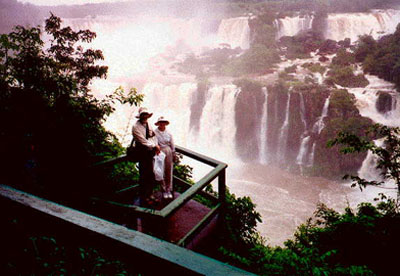 |
 |
| Lois and Jason on lookout on Brazilian side | Falls from boat |
And, of course, if that wasn't enough, there was the boat ride to
take you into the falls to be really up close and personal...
The way in which the Iguazu River flows, only one fall, "garganta
del diablo" (the devil's throat), is on the Brazilian side of the
river. All the other falls are on the Argentinean side. We began
our Iguazu experience on the Argentina side. From our hotel room
we could see the tops of many falls, and only the mist where
garganta del diablo crashed to the river below, creating clouds of
mist. (By the way, we never got to the swimming pool!)
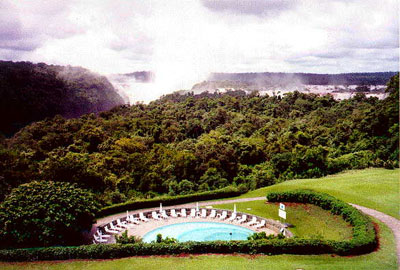 |
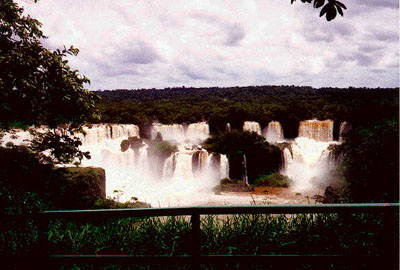 |
| View from hotel room on Argentina side | View from Brazilian side of river |
We spent two full days exploring the Argentinean walkways. Since
almost all the falls are on the Argentinean side of the river,
most of the views were from along side a fall, or very close to a
fall. It was awesome.
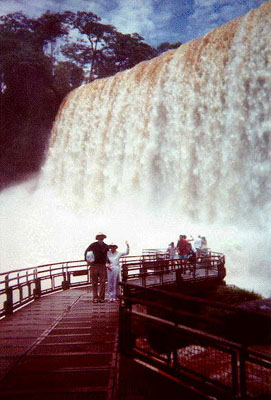 |
 |
| Lois and Jason on bridge at foot of fall on Argentina side | Observation platform in middle of garganta del diablo, Brazilian side |
To gain a general perspective of an entire fall, or series of
falls, we needed to go to the Brazilian side. So, we took a
day trip to the other side of the river, and it was again
indescribable. From the Brazilian side we could get a full-frontal
view of a series of falls,...and go to the middle of garganta del
diablo.
Our Iguazu Falls experience was enriched by the hundreds of
butterflies, gigantic spider webs, and beautiful birds and flowers
which we saw.
aaa
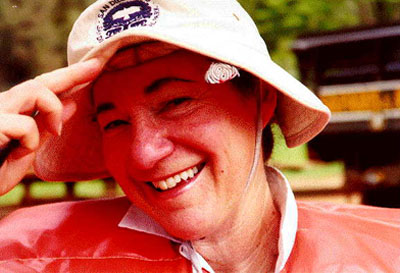 |
 |
| Lois with butterfly on hat | Toucan on fence |
And, we could never escape the sound of the falls, the constant roar which enveloped the entire area. There was one other sound which fascinated us to no end: we could swear we heard rain birds running everywhere we went. It curtained explained why everything was so green!
There were two walking streets in Buenos Aires which are perpendicular to each other, forming a + . One, Florida was much like the very upscale walking streets we've visited in Europe or the US. The store were well stocked with find clothes. There were many camera and other luxury item shops, travel agencies, and restaurant dining (including McDonalds). The old Buenos Aires train station was along Florida and was converted into a shopping mall, one which could compete with shops in any upscale local like those of Rodeo Drive in Beverly Hills. The second street, Lavalle, ran perpendicular to Florida, and seems to be oriented toward the teen population. Video arcades, movie theaters, and inexpensive fast food (with hamburgers and hot dogs rather than empanadas or tacos) line the six block stretch. All the movie were recent American films, dubbed in Spanish. Afternoon shows were $3.50, with evening shows $7.00. We didn't find out if they sell popcorn.
Traffic in Buenos Aires was very congested, and scary. There didn't seem to be any rules regarding turning. People literally turned left from a right lane and right from a left lane. When crossing we felt like we were the toreadors dodging the bulls which were charging down on us. We were amazed we didn't see any accidents, so we guess the locals know what they were doing. Walking was equally challenging as pot holes were more common on the sidewalks than in the streets. Rather than fix them, there were wooden slats laid across them.
Evita is a big draw for tourist (and the locals as well). We visited the pink presidential palace (and saw the balcony from which she would give her speeches and throw money to the masses) as well as her tomb at the cemetery in Recolet. This cemetery is the burial ground for the rich and famous of Buenos Aires, and consisted of row after row of mausoleums, laid out as if it were a city unto itself. These were in Greek and Roman architecture, with pillars and statues, many of incredible detail and workmanship. There was a map at the entrance, listing names and indicating the "street" were the various tombs were. Most of the tombs were above ground.
One day we visited an Estancia (ranch) on the Pampas, the vast plain region of Argentina famous for its cattle ranching and gauchos. It seemed very much like the mid-west, with flat or low rolling country side. We had an opportunity to take a buggy ride, sit on a horse to have our picture taken, and watch a rodeo in which the horsemanship of the gauchos was demonstrated. The asado (bbq) was excellent, as was the tango show which followed.
Speaking of tango, how could one go to Buenos Aires and not go to a Tango club. We visited one for a dinner show, and it made us question whether this was really a local custom or just a tourist thing. On Sunday afternoon we visited the San Telmo district, the place where Tango was reported to have been created just over a hundred years ago. The area has cobble stone streets lined with European type building with rod iron balconies, and alive with street actor, posing as living statues or dancing the tango. In one plaza there was an outdoor arts and crafts market. The center of the plaza had a dance area where couples were doing the tango.
One afternoon we visited the main Jewish synagogue, which had a museum of the history of the Jew in Buenos Aires and an art gallery. The synagogue was build in 1882, and there are 18 active Jewish congregations in the Buenos Aires area now.
As we flew into Buenos Aires we spotted from the air a vast shanty town. But then on the other side there were gorgeous home, each with its own swimming pool and many with tennis courts. As we drove from the airport into the heart of the city, we again passed a very large area of makeshift homes. Yet, as we walked the streets of Buenos Aires we saw very little poverty, no street people, and very little begging. The city from the air appear to have a very uniform look of low and high rise building, distributed everywhere. There was no sense of a downtown with a cluster of high rises.
We were amazed that the Argentina peso is pegged to the American dollar (one US dollars equals one Argentinean peso), and yet food, clothes, restaurants, movie, and transportation were the same as at home. In fact, I paid only fifty cents for a bus at home and it was sixty for the bus and subway in Buenos Aires. One morning we visited the botanic gardens. Not only was there a great display of South American plants, there was a magnificent Redwood. The grounds man took us into the library area to help us identify some of the flowers which were so beautiful.
Aside from the very hot temperatures (around 90 degrees) and very
high humidity (around 90 percent), Buenos Aires provided us with a
very different perspective than our other visits to Latin American
cities.